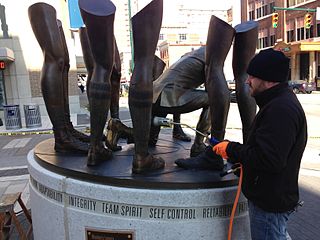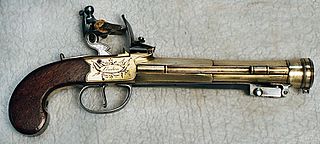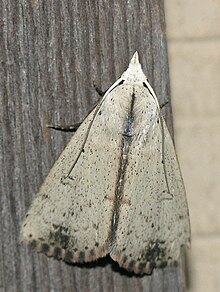
The conservation and restoration of cultural property focuses on protection and care of cultural property, including artworks, architecture, archaeology, and museum collections. Conservation activities include preventive conservation, examination, documentation, research, treatment, and education. This field is closely allied with conservation science, curators and registrars.

A conservator-restorer is a professional responsible for the preservation of artistic and cultural artifacts, also known as cultural heritage. Conservators possess the expertise to preserve cultural heritage in a way that retains the integrity of the object, building or site, including its historical significance, context and aesthetic or visual aspects. This kind of preservation is done by analyzing and assessing the condition of cultural property, understanding processes and evidence of deterioration, planning collections care or site management strategies that prevent damage, carrying out conservation treatments, and conducting research. A conservator's job is to ensure that the objects in a museum's collection are kept in the best possible condition, as well as to serve the museum's mission to bring art before the public.

Conservation and restoration of metals is the activity devoted to the protection and preservation of historical and archaeological objects made partly or entirely of metal. In it are included all activities aimed at preventing or slowing deterioration of items, as well as improving accessibility and readability of the objects of cultural heritage. Despite the fact that metals are generally considered as relatively permanent and stable materials, in contact with the environment they deteriorate gradually, some faster and some much slower. This applies especially to archaeological finds.
Conservation and restoration of movable cultural property is a term used to denote the conservation of movable cultural property items in libraries, archives, museums and private collections. Conservation encompasses all the actions taken toward the long-term preservation of cultural heritage. Activities include examination, documentation, treatment, and preventive care, which is supported by research and education. Object conservation is specifically the actions taken to preserve and restore cultural objects. The objects span a wide range of materials from a variety of cultures, time periods, and functions. Object conservation can be applied to both art objects and artifacts. Conservation practice aims to prevent damage from occurring, a process known as 'preventive conservation'. The purpose of preventive conservation is to maintain, and where possible enhance, the condition of an object, as well as managing deterioration risks, such as handling and environmental conditions. Historically, object conservation was focused on the category of fine arts but now many different types of objects are conserved. Each type of object material, typically denoted by organic or inorganic then the specific medium, requires a specialized professional conservator and often requires collaborative work between museum staff, scientists, and conservators.

The conservation and restoration of silver objects is an activity dedicated to the preservation and protection of objects of historical and personal value made from silver. When applied to cultural heritage this activity is generally undertaken by a conservator-restorer.

Iron, steel, and ferrous metals constitute a large portion of collections in museums. The conservation and restoration of iron and steel objects is an activity dedicated to the preservation and protection of objects of historical and personal value made from iron or steel. When applied to cultural heritage this activity is generally undertaken by a conservator-restorer. Historically, objects made from iron or steel were created for religious, artistic, technical, military and domestic uses. Though it is generally not possible to completely halt deterioration of any object, the act of conservation and restoration strives to prevent and slow the deterioration of the object as well as protecting the object for future use. One of the first steps in caring for iron is to examine them and determine their state, determine if they are corroding, and consider options for treatment.

A conservation technician is a specialist in conservation methods pertaining to cultural property, and who may work in museums or public or private conservation organizations. A technician may also work in conjunction with other collection staff, such as a registrar (museum) or collection manager.

The conservation and restoration of outdoor artworks is the activity dedicated to the preservation and protection of artworks that are exhibited or permanently installed outside. These works may be made of wood, stone, ceramic material, plastic, bronze, copper, or any other number of materials and may or may not be painted. When applied to cultural heritage this activity is generally undertaken by a conservator-restorer.

The conservation and restoration of books, manuscripts, documents, and ephemera is an activity dedicated to extending the life of items of historical and personal value made primarily from paper, parchment, and leather. When applied to cultural heritage, conservation activities are generally undertaken by a conservator. The primary goal of conservation is to extend the lifespan of the object as well as maintaining its integrity by keeping all additions reversible. Conservation of books and paper involves techniques of bookbinding, restoration, paper chemistry, and other material technologies including preservation and archival techniques.

A conservation scientist is a museum professional who works in the field of conservation science and whose focus is on the research of cultural heritage through scientific inquiry. Conservation scientists conduct applied scientific research and techniques to determine the material, chemical, and technical aspects of cultural heritage. The technical information conservation scientists gather is then used by conservator and curators to decide the most suitable conservation treatments for the examined object and/or adds to our knowledge about the object by providing answers about the material composition, fabrication, authenticity, and previous restoration treatments.

A photograph conservator is a professional who examines, documents, researches, and treats photographs, including documenting the structure and condition of art works through written and photographic records, monitoring conditions of works in storage and exhibition and transit environments. This person also performs all aspects of the treatment of photographs and related artworks with adherence to the professional Code of Ethics.

The conservation and restoration of wooden furniture is an activity dedicated to the preservation and protection of wooden furniture objects of historical and personal value. When applied to cultural heritage this activity is generally undertaken by a conservator-restorer. Furniture conservation and restoration can be divided into two general areas: structure and finish. Structure generally relates to wood and can be divided into solid, joined, and veneered wood. The finish of furniture can be painted or transparent.

A textile conservator is a conservator-restorer charged with the care, treatment, research, and preservation of textiles. Issues addressed by a textile conservator are generally related to the field of textile preservation, and include damage caused to textiles by: light, mold and mildew, insects, cleaning, surface cleaning, washing, mounting for display, and storage. Variations in textile types and “the diversity of the textile conservator’s work makes it a very rewarding profession”. Textiles are among the most fragile artifacts, as they are susceptible to damage from atmospheric pollutants, moisture, biological organisms, and environmental changes and care varies with size, shape, material, and condition issues, all of which a textile conservator must be well versed.

The conservation and restoration of clocks refers to the care given to the physical and functional aspects of time measuring devices featuring "moving hands on a dial face" exclusive of watches. Care for clocks constitutes regulating the external environment, cleaning, winding, lubrication, pest-management, and repairing or replacing mechanical and aesthetic components to preserve or achieve the desired state as specified by the owner. Clocks are typically composed of multiple types of materials such as wood, metal, paint, plastic, etc., which have unique behaviors and environmental interactions, making treatment options complex. The materials used and the complexity of clockwork warrant having a Horological Conservator complete the work.

Conservation-restoration of bone, horn, and antler objects involves the processes by which the deterioration of objects either containing or made from bone, horn, and antler is contained and prevented. Their use has been documented throughout history in many societal groups as these materials are durable, plentiful, versatile, and naturally occurring/replenishing.

The conservation and restoration of paintings is carried out by professional painting conservators. Paintings cover a wide range of various mediums, materials, and their supports. Painting types include fine art to decorative and functional objects spanning from acrylics, frescoes, and oil paint on various surfaces, egg tempera on panels and canvas, lacquer painting, water color and more. Knowing the materials of any given painting and its support allows for the proper restoration and conservation practices. All components of a painting will react to its environment differently, and impact the artwork as a whole. These material components along with collections care will determine the longevity of a painting. The first steps to conservation and restoration is preventive conservation followed by active restoration with the artist's intent in mind.
The conservation and restoration of ancient Greek pottery is a sub-section of the broader topic of conservation and restoration of ceramic objects. Ancient Greek pottery is one of the most commonly found types of artifacts from the ancient Greek world. The information learned from vase paintings forms the foundation of modern knowledge of ancient Greek art and culture. Most ancient Greek pottery is terracotta, a type of earthenware ceramic, dating from the 11th century BCE through the 1st century CE. The objects are usually excavated from archaeological sites in broken pieces, or shards, and then reassembled. Some have been discovered intact in tombs. Professional conservator-restorers, often in collaboration with curators and conservation scientists, undertake the conservation-restoration of ancient Greek pottery.
The conservation-restoration of panel paintings involves preventive and treatment measures taken by paintings conservators to slow deterioration, preserve, and repair damage. Panel paintings consist of a wood support, a ground, and an image layer. They are typically constructed of two or more panels joined together by crossbeam braces which can separate due to age and material instability caused by fluctuations in relative humidity and temperature. These factors compromise structural integrity and can lead to warping and paint flaking. Because wood is particularly susceptible to pest damage, an IPM plan and regulation of the conditions in storage and display are essential. Past treatments that have fallen out of favor because they can cause permanent damage include transfer of the painting onto a new support, planing, and heavy cradling. Today's conservators often have to remediate damage from previous restoration efforts. Modern conservation-restoration techniques favor minimal intervention that accommodates wood's natural tendency to react to environmental changes. Treatments may include applying flexible battens to minimize deformation or simply leaving distortions alone, instead focusing on preventive care to preserve the artwork in its original state.

The Conservation of South Asian household shrines is an activity dedicated to the preservation of household shrines from South Asia. When applied to cultural heritage, held by either museums or private collectors, this activity is generally undertaken by a conservator-restorer. South Asian shrines held in museum collections around the world are principally shrines relate to Hindu, Jain, or Buddhist households. Due to their original use and sacred nature, these shrines present unique conservation and restoration challenges for those tasked with their care.

The conservation and restoration of historic firearms is preventative care, damage repair, stabilization, replacement of missing components, and potentially the return of the firearm to firing capabilities. It requires an understanding of the different types of historic firearms and knowledge in the care and treatment of organic and inorganic materials, as firearms are composed of many types of materials, from wood to metal, that are fitted together.



















